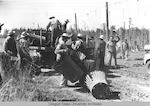Editor’s note: OPB’s video series “Superabundant” explores the stories behind the foods of the Pacific Northwest. Now we’re taking the same guiding principles to a new platform: Email. We’ve brought on food writer Heather Arndt Anderson, a Portland-based culinary historian and botanist, to highlight different aspects of the region’s food ecosystem every week. Read below to get a taste of Friday’s newsletter, where Arndt Anderson explores the history of hops and beer in the Northwest.
Small bites: Filberts, fowl and farming the sea
Aw, nuts: Oregon hazelnuts take a price dive. It’s been a perfect storm of unfortunate events for Oregon’s hazelnut growers. This year’s harvest has been fine — great, even — but Turkey (the world’s leading producer of hazelnuts) has had an incredible year for hazelnuts, flooding the global market with a 20% increase in supply and dropping the price. But look on the bright side, filbert fans: Shipping complications in China (a major consumer of Oregon hazelnuts) means more of our local product is staying put.
Backyard hens are looking pretty darn weird right about now. If you leave your backyard hens to a natural laying cycle rather than keeping lights in their coop, you’ve probably noticed that they start slowing down on eggs this time of year, as the daylight hours slowly ebb toward winter. Some hens use this opportunity to drop their old feathers, or molt, since they can use that egg energy on growing fresh feathers instead. If you keep hens, this is a good time to feed them a little extra protein or, if you’re a homebrewer, you can give them your spent grain.
More seaweed farms may be on the horizon. Tom Banse reports that the Pacific Northwest could soon see a huge jump in the number of seaweed farms — double or even triple the current number if permitting goes smoothly. Just as growing mussels and oysters does, farming kelp can improve water quality. According to a 2019 study published in PLOS ONE, aquaculture of shellfish and seaweed can de-acidify ocean water, increase habitat for aquatic organisms, and ultimately benefit fish stocks.
Come on, get hoppy
You’ve got to love a harvest festival — a time to celebrate the bounty and revel in (super)abundance. The Chinese Mid-Autumn Festival was a few weeks ago, and the Jewish harvest holiday Sukkot is just around the corner. Residents of Mt. Angel may have packed up their Oktoberfest garb for the year, but here in the Pacific Northwest the hops harvest has just begun. Today, Oregon and Washington produce more hops than anywhere else in the world. Heck, you’ve probably got a neighbor growing some, if they’re not in your own yard.

People gather hops in an image of unknown origins. Hops have been grown in the Willamette Valley for over a century.
Unknown / Volgagermansportland
Though we still tend to associate hops with Germans, the history of growing and harvesting hops in the Willamette Valley is interwoven with the histories of multicultural laborers who helped grow and harvest the plants. Harvesting hops is treacherous work — the bines (what hop vines are called) are covered in tiny spines that feel like razor wire Velcro — and it all must be done at once when the hops ripen, before the rains come and spoil the crop. Before the mid-20th Century, finding enough labor was always a challenge, and farmers usually turned to seasonal help to complete the task.
Many hands make light work, but machines make it even lighter
In September 1928, The Oregonian reported that the Willamette Valley had between 35,000 and 40,000 hops pickers in the fields. Chinese, Japanese, Mexican, and Indigenous laborers toiled alongside white pickers to get the cones into trucks lickety-split, off to dry before being shipped around the world and finally becoming beer.
In her excellent documentary Bitter Harvest, filmmaker Ivy Lin chronicles the struggles Chinese hops workers faced while farming the Willamette Valley around the turn of the 20th century. Chinese hops pickers were paid only 80 cents for every dollar white pickers earned, and because of the Chinese Exclusion Act of 1882, Chinese farmers weren’t allowed to own property, relying instead on renting land to grow hops. To learn more about how Chinese hops workers helped secure Oregon’s place as a beer mecca, read Putsata Reang’s essay (which accompanies Lin’s film) in Oregon Humanities.

Braceros work in Pacific Northwest hops fields, in an undated image from Oregon State University archives.
Oregon State University Archives / OPB
During World War II, there was a farm labor shortage as men and women enlisted in the military or took higher-paying jobs in factories. Then-President Franklin Roosevelt signed Executive Order 9066, which imprisoned more than 125,000 Japanese Americans, including the 4,000 people sent from Oregon to the Minidoka War Relocation Center in Idaho. The Bracero program, a labor agreement between the U.S. and Mexico in 1942, brought contracted workers from Mexico to pick up some of the slack. The program ended in 1964, but by the 1950s (a decade before the Bracero program ended), hops were mostly being harvested by machines.
Why do we grow so many hops here, anyway?

Side-by-side images of growing hops.
Heather Arndt Anderson / OPB
It bears repeating that Oregon’s geographic position at (roughly) the 45th parallel, our Mediterranean climate, ample rainfall, and volcanic soils mean that we can grow a lot of wonderful things to eat and drink. When it comes to beer specifically we’ve got the water, the wheat, and the hops to make it shine. In many ways, beer is a perfect symbol of all that our state has to offer.
In 1805, during Lewis and Clark’s expedition, their hunter John Collins brewed Oregon’s first beer when the camas cakes they’d purchased on the Columbia began to ferment. (The Corps reported that paired with their breakfast of fish and dog meat, they enjoyed “Some excellent beer … which was verry good.”) Breweries were part of Portland’s fabric from its very inception, and much of the city’s early wealth was built on booze. Oregon is home to many of the country’s oldest microbrewpubs (and our craft non-alcoholic beer and hop seltzer scene is currently thriving), but homebrewing also has a long history here. F.H. Steinbart in Portland is America’s oldest homebrewing supply store — they even had the audacity to open during Prohibition (in Oregon, dry laws went on the books in 1915), keeping with our Wild West reputation nicely.
Hops might be best known as a beer bittering agent, but they’re also a natural preservative, helping beer stay clear and un-skunky. Although India pale ale (IPA) had been around since the 18th century, Northwest hop varieties like Cascade and Chinook took IPAs to their modern zenith. Today’s hop bros have sent beer on an ever-climbing journey up IBU Mountain, sort of like how chileheads are always on the quest for more Scovilles.
Recipe: Cheese-beer bread

Cheese and beer bread.
Heather Arndt Anderson / OPB
What better way to enjoy a crisp beer than with a slice of warm, cheesy beer bread? You can use whatever beer you have laying around for this recipe, but we like the flavor of a wheaty, malty Weissbier here, which balances well with a sharp cheese.
Ingredients
- 2 ½ cups all-purpose flour
- ½ cup whole wheat flour
- 3 tsp baking powder 2 tbsp sugar
- 1 tsp kosher salt
- ½ tsp ground black pepper
- 12 oz beer
- ¼ cup vegetable oil or melted butter
- ½ cup shredded or finely diced cheese (sharp cheddar works well here)
Instructions
- Position a rack in the middle of your oven, preheat to 350 degrees, and grease a loaf pan. (You can add a strip of parchment down the center if sticking is an issue!)
- Whisk together the flours, baking powder, sugar, salt and pepper in a medium mixing bowl. Pour in the beer and oil or melted butter and mix until combined, then stir in the cheese.
- Scrape the thick batter into the prepared pan and bake for 50-60 minutes (or until a toothpick inserted in the middle comes out clean), then run a knife along the edge of the loaf to dislodge it. Gently turn it out onto a cooling rack and cool for 20 minutes before slicing.
Dear Reader,
For more than 100 years, OPB has offered reliable news and connection. Through wildfires, elections and economic downturns, OPB has been there to inform and connect our communities. Today, journalism faces new obstacles.
But this work is only possible because of people like you — readers who turn to articles like this and continue to engage with independent journalism in our community. If OPB has been a part of your life, if it has helped you see your community or the world more clearly, please consider making a contribution today.
— The OPB Team
Please select an amount to give. Your contribution ensures that fact-based reporting, cultural connection, and stories that strengthen our community remain freely available to everyone.

